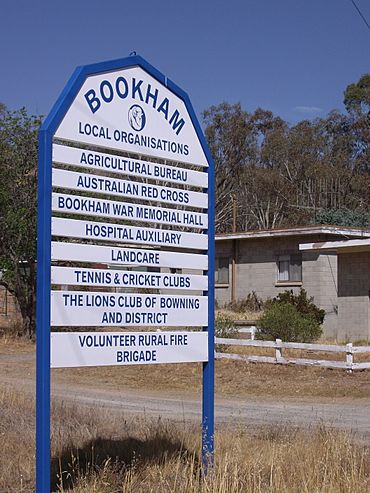Bookham, New South Wales facts for kids
Quick facts for kids BookhamNew South Wales |
|||||||||||||||
|---|---|---|---|---|---|---|---|---|---|---|---|---|---|---|---|

Entering Bookham
|
|||||||||||||||
| Postcode(s) | 2582 | ||||||||||||||
| Elevation | 464–737 m (1,522–2,418 ft) | ||||||||||||||
| Location |
|
||||||||||||||
| LGA(s) | Yass Valley Council | ||||||||||||||
| County | Harden | ||||||||||||||
| State electorate(s) | Goulburn | ||||||||||||||
| Federal Division(s) | Eden-Monaro | ||||||||||||||
|
|||||||||||||||
|
|||||||||||||||
Bookham is a small village in New South Wales, Australia. It is located in the South West Slopes and Riverina regions. You can find it about 29 kilometers (18 miles) west of Yass, right on the Hume Highway. It is part of the Yass Valley Shire.
Contents
History of Bookham
The area where Bookham now stands was once known as Bogolong. A famous Australian poet, Banjo Paterson, was inspired by childhood memories of races at the Bogalong Racetrack. These memories helped him write his poem Old Pardon the Son of Reprieve.
How Bookham Got Its Name
The name of the village changed in 1839. This happened when Lady Jane Franklin visited the area. She was the wife of John Franklin, who was the Lieutenant Governor of Van Diemen's Land. Lady Franklin was the first European woman to travel overland from Port Phillip to Sydney.
Soon after her visit, a plan for a village called Cumbookambookinah was made. This long name was later shortened to Bookham. By August 1839, the name Bookham was being used officially.
There is a fun story about the town's name. Some people say police used to hide here to "book 'em" (give tickets to) drivers who were speeding. The story goes that truck drivers would sometimes drop a newspaper or other small item near the police hiding spot. This was a warning to other drivers.
Early Industries and Ideas
In 1874, iron was made in Bookham. This happened at a place on Jugiong Creek, about 3 kilometers (1.9 miles) north of the village. The Bogolong Iron Mining Company used iron ore found nearby.
Today, you can still see parts of the old blast furnace. It is one of only three 19th-century blast furnace ruins in Australia. It is the only one in New South Wales. This site is important for history and is listed in the N.S.W. heritage database.
A part of Bookham was once considered for Australia's national capital city. This proposed site was called Mahkoolma. If it had been chosen, Bookham village would have become part of the capital territory.
Post Office and Churches
The Bookham Post Office opened on 1 September 1864. It helped deliver mail, including a mail run from Tumut that started in 1882. The Post Office closed in 1993. Its most recent building is now a cafe called Barney's of Bookham.
Bookham has two churches that are still standing. One is the Uniting Church, built around 1926. The other is St. Columba's Catholic Church, built around 1910. St. Columba's Catholic Church has been beautifully restored. It is now used as stylish accommodation for visitors and is called The Old Bookham Church.
Population
At the 2016 census, Bookham had a population of 161 people. Most people (82.7%) were born in Australia. Also, most people (87.7%) spoke only English at home.
Climate
Bookham is located between the western slopes of New South Wales and the dividing mountain range. Because of this, its weather changes a lot between seasons. It has a clear peak in rainfall during winter. Snowfall is also quite common in Bookham.
| Climate data for Red Hill State Forest (1938–1970); 640 m AMSL; 35.17° S, 148.37° E | |||||||||||||
|---|---|---|---|---|---|---|---|---|---|---|---|---|---|
| Month | Jan | Feb | Mar | Apr | May | Jun | Jul | Aug | Sep | Oct | Nov | Dec | Year |
| Mean daily maximum °C (°F) | 28.7 (83.7) |
27.8 (82.0) |
25.1 (77.2) |
19.5 (67.1) |
14.5 (58.1) |
11.1 (52.0) |
10.0 (50.0) |
11.7 (53.1) |
15.3 (59.5) |
18.6 (65.5) |
21.9 (71.4) |
26.3 (79.3) |
19.2 (66.6) |
| Mean daily minimum °C (°F) | 12.5 (54.5) |
12.8 (55.0) |
10.5 (50.9) |
6.7 (44.1) |
3.7 (38.7) |
1.9 (35.4) |
0.8 (33.4) |
1.5 (34.7) |
3.3 (37.9) |
5.9 (42.6) |
8.0 (46.4) |
10.8 (51.4) |
6.5 (43.7) |
| Average precipitation mm (inches) | 73.3 (2.89) |
56.1 (2.21) |
76.1 (3.00) |
78.6 (3.09) |
108.3 (4.26) |
96.5 (3.80) |
117.0 (4.61) |
118.9 (4.68) |
91.5 (3.60) |
105.3 (4.15) |
85.1 (3.35) |
70.0 (2.76) |
1,076.7 (42.39) |
| Average precipitation days (≥ 0.2 mm) | 6.5 | 5.9 | 6.3 | 8.1 | 11.8 | 12.9 | 14.5 | 15.2 | 11.5 | 12.1 | 9.2 | 7.5 | 121.5 |
| Source: Australian Bureau of Meteorology; Red Hill State Forest | |||||||||||||
Gallery
-
Upper part of Bogolong blast furnace ruin







